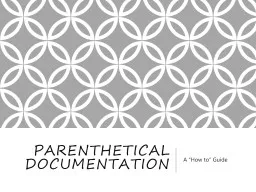

A How to Guide What is Parenthetical Documentation In MLA style referring to the works of others in your text is done by using what is known as parenthetical citation This method involves placing relevant source information in parentheses after a quote or a paraphrase ID: 552744
Download Presentation The PPT/PDF document "Parenthetical documentation" is the property of its rightful owner. Permission is granted to download and print the materials on this web site for personal, non-commercial use only, and to display it on your personal computer provided you do not modify the materials and that you retain all copyright notices contained in the materials. By downloading content from our website, you accept the terms of this agreement.
Slide1
Parenthetical documentation
A “How to” GuideSlide2
What is Parenthetical Documentation?
In MLA style, referring to the works of others in your text is done by using what is known as parenthetical citation. This method involves placing relevant source information in parentheses after a quote or a paraphrase.
Today, we are learning about parenthetical documentation, so we will cover works
cited later on.Slide3
Guidelines
Any source information you use in-text must correspond with the source information you have on your Works Cited page.
Whatever signal word or phrase you place in-text, must be the first thing that appears on the left-hand margin of the corresponding entry in the Works Cited List.
The source information depends:
upon the source medium (e.g. Print, Web, DVD)
upon the source’s entry on the Works Cited (bibliography) page.Slide4
In-Text Citations - Print: Known Author
For Print sources like books, magazines, scholarly journal articles, and newspapers, provide a signal word or phrase (usually the author’s name) and a page number. If you provide the signal word/phrase in the sentence, you
do not
need to include it in the parenthetical citation.
Human beings have been described by Kenneth Burke as “symbol-using animals” (3).
Human beings have been described as “symbol-using animals” (Burke 3).
Works Cited page:
Burke, Kenneth.
Language as Symbolic Action: Essays on Life, Literature, and Method
. Berkeley: U of California P, 1966. Print.Slide5
In-Text Citations - Print: no Known Author
When a source has no known author, use a shortened title of the work instead of an author name. Place the title in quotation marks if it’s a short work (such as an article) or italicize it if it’s a longer work. (e.g. plays, books, television shows, entire Web sites) and provide a page number.
We see so many global warming hotspots in North America likely because this region has “more readily accessible climatic data and more comprehensive programs to monitor and study environmental change…” (“Impact of Global Warming” 6).
In this example, since the reader does not know the author of the article, an abbreviated title of the article appears in the parenthetical citation which corresponds to the full name of the article which appears first at the left-hand margin of its respective entry in the Works Cited.
Works Cited page:
“The Impact of Global Warming in North America.”
Global Warming: Early Signs
. 1999. Web. 23 Mar. 2009.Slide6
In-Text Citations – Multiple editions
Page numbers are always required, but additional information may be needed if there is a different edition of a classic work like Marx and Engle’s
The Communist Manifesto.
In such situations, give the page number of your edition (the edition needs to be listed in your Works Cited page) followed by a semicolon, and then the appropriate abbreviations for volume (vol.), book (bk.), part (pt.), chapter (
ch
.), section (sec.), or paragraph (par.).
Marx and Engels described human history as marked by class struggles (79; ch.1).Slide7
In-Text Citations – Authors with Same Last name
If two authors have the same last name, use both author’s first initials.
Although some medical ethicists claim that cloning will lead to designer children (R. Miller 12), others note that the advantages for medical research outweigh this consideration (A. Miller 46).Slide8
In-Text Citations – multiple Authors Source
If you have a source with multiple authors, list the author’s last names in the text or in the parenthetical citation.
Smith, Yang, and Moore argue that tougher gun control is not needed in the United States (76).
The authors state “Tighter gun control in the United States erodes Second Amendment rights” (Smith, Yang, and Moore 76).Slide9
In-Text Citations – two Works by the Same Author
If you have used two works by the same author, you will need to place a shortened title for the particular work from which you are quoting to distinguish it from the others.
Lightenor has argued that computers are not useful tools for small children (“Too Soon” 38), though he has acknowledged elsewhere that early exposure to computer games does lead to better small motor skill development in a child’s second and third year (“Hand –Eye Development” 17).
Visual studies, because it is such a new discipline, may be “too easy” (Elkins, “Visual Studies” 63).Slide10
Works Cited
Russell, Tony, Allen
Brizee
, Elizabeth
Angeli
, Russell Keck, and Joshua M.
Paiz
. "Online Writing Website."
Perdue Owl
. Perdue University, 03 06 2014. Web. 24 Mar 2014.